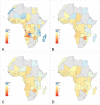Changes in the spatial distribution of the under-five mortality rate: Small-area analysis of 122 DHS surveys in 262 subregions of 35 countries in Africa
- PMID: 30668609
- PMCID: PMC6342310
- DOI: 10.1371/journal.pone.0210645
Changes in the spatial distribution of the under-five mortality rate: Small-area analysis of 122 DHS surveys in 262 subregions of 35 countries in Africa
Abstract
The under-five mortality rate (U5MR) is a critical and widely available population health indicator. Both the MDGs and SDGs define targets for improvement in the U5MR, and the SDGs require spatial disaggregation of indicators. We estimate trends in the U5MR for Admin-1 subnational areas using 122 DHS surveys in 35 countries in Africa and assess progress toward the MDG target reductions for each subnational region and each country as a whole. In each country, direct weighted estimates of the U5MR from each survey are calculated and combined into a single estimate for each Admin-1 region across five-year periods. Our method fully accounts for the sample design of each survey. The region-time-specific estimates are smoothed using a Bayesian, space-time model that produces more precise estimates (when compared to the direct estimates) at a one-year scale that are consistent with each other in both space and time. The resulting estimated distributions of the U5MR are summarized and used to assess subnational progress toward the MDG 4 target of two-thirds reduction in the U5MR during 1990-2015. Our space-time modeling approach is tractable and can be readily applied to a large collection of sample survey data. Subnational, regional spatial heterogeneity in the levels and trends in the U5MR vary considerably across Africa. There is no generalizable pattern between spatial heterogeneity and levels or trends in the U5MR. Subnational, small-area estimates of the U5MR: (i) identify subnational regions where interventions are still necessary and those where improvement is well under way; and (ii) countries where there is very little spatial variation and others where there are important differences between subregions in both levels and trends. More work is necessary to improve both the data sources and methods necessary to adequately measure subnational progress toward the SDG child survival targets.
Conflict of interest statement
The authors have declared that no competing interests exist.
Figures



References
-
- Li N. Estimating Life Tables for Developing Countries. https://goo.gl/N2fMZx: United Nations Department of Economic and Social Affairs Population Division; 2015. 2014/4.
-
- United Nations General Assembly. Keeping the promise: united to achieve the Millennium Development Goals; 2010. Resolution Adopted by the General Assembly: 65/1.https://goo.gl/GK2AhU.
-
- United Nations. Millennium Development Goals; 2017.
-
- United Nations General Assembly. Transforming our world: the 2030 Agenda for Sustainable Development; 2015. Resolution Adopted by the General Assembly on 25 September 2015: 70/1.https://goo.gl/UBddEC.
Publication types
MeSH terms
Grants and funding
LinkOut - more resources
Full Text Sources

